Below are the Weapons we train with

Katana - Japan -The smaurai's weapon of choice. Sword schools spend many years perfecting the art of the sword and has many uses on and off the battlefields. The art of fast drawing the sword is known as 'Iai-do' and the method of using a drawn sword is known as 'Kenjutsu'. We train in both Iai-do and Kenjutsu.

Wakizashi - Japan - A side arm of the samurai, shorter than the katana. Would be sometimes worn with the katana as a 'daisho' (pair) of swords. Would normally be used inside buildings and would sometimes be made from broken katana blades.
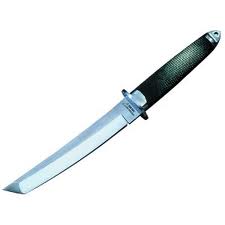
Tanto - Japan - Would be used single or double, in the hand or to be thrown. Samurai would use in close quarter combat and the traditional Okinawan villages was only allowed one knife per village used to cut meat ect.. a weapon also used by ladies.
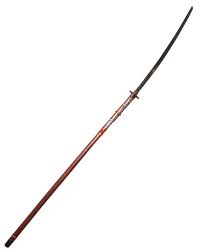
Naginata - Japan - The Japanese spear, not to be confused with the 'Yari' this weapon was used on the battlefields to cut enemies from horses or used by the ladies back home at the village to protect against intruders while the men were away fight. Also used as a firefighting tool.

Yari - Japan / China - Unlike the Naginata the Yari has a straight blade, the Naginata was a slashing weapon where the Yari was used more as a thrusting / throwing weapon. The tang would be just as long as the blade making it very hard to break in combat.

Sai - Okinawa / China - This weapon has many origins. A fishermans gaff? The top of a farmers pitching fork? Okinawan Police tool? Centre spoke of a wheel? One thing is this weapon is lethal against longer weapons such as the katana, Naginata ect.. Used singular, in pairs or three's with one being thrown or used to pin opponents to the floor. The Okinawan Police Officers would use these and would be a symbol of authority.
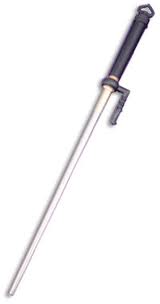
Jitte - Japan - This was the main weapon the Japanese Police force used. With a smaller tine than the sai it was ideal for trapping a katana blade before making an arrest. There would be different tines and coloured Ito's / cords depending on the officer's rank / station.

Tonfa - Okinawa / China - Originated as a handle from a mill stone from the farmer or a simple hook used in the house. Would usually be used in pairs. The US police force use it singular today as the PR-24. Also this weapon could have originated from China and was used as part of a crutch.
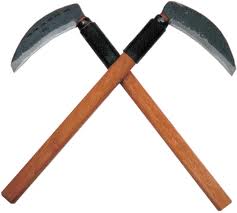
Kama - Okinawa - This weapon came from the fields of Okinawa and was used as a basic tool to cut crops. the inner edge would be sharp and the outer edge blunt. There is alo a variation of the kama called 'Kusarigama'

Kusarigama - Okinawa / Japan - A variation of the Kama, this was used by the ninja and farmers to defend against the samurai. The length of the chain made this weapon easy to keep an opponent at distance but very hard to make look like anything other than a weapon.

Nunchaku - Okinawa - This weapon has been devised from several farming tools. A crop 'crusher' or horses reigns. Made famous by Bruce Lee this weapon has now been banned to non-martial artist due to its devastating attacking force. Its a very hard weapon to defend against due to the break in the cord but also weak to defend with due to its size. Made originally with horses hair to connect the two wooden shafts, modern days chain is used.

Bo - Worldwide - The bo, or 'Rokushakubo' to use its true name is one of the longest weapons used by the people of Okinawa. It originated from a balancing pole to carry buckets of water or crops over the shoulder. Usually made of white or red oak but also made of ratten or bamboo, the bo is also made straight or tapered. This weapon could just be a simple piece of stick found all over the world and depending where will depend on the material used like Oak, Bamboo, Ratten ect..
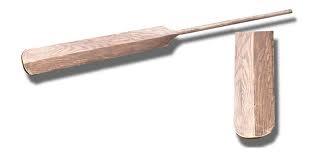
Eku - Okinawa - The oar is a true fishermans tool and is used in a similar manner to the bo. The advantage is the large striking area of the paddle which was used to flick sand or dirt into the opponents eyes or to use the edge to strike with.

Jo - Worldwide - The Jo could have been anything from a piece of stick on the floor to a farming handle of some form. One of the most versitile weapons it can be used like a bo, katana or tanjo. This was the only weapon to supposedly to defeat Miyamoto Musashi in battle.
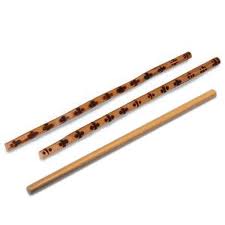
Hanbo / Tanjo / Escrima - Worldwide - All roughly arm length weapons and are sticks found on the floor. Made of red / white oak, ratten or bamboo and used singular or in pairs dependant on the style.

Bolo / Machette - Philippines - Again used similar to the Hanbo / Tanjo / Escrima but rather than a hitting you would slash. Used in the forest to chop down crops and to prepare fruit / veg in the market areas.

Yawara bo / Kobutan / Pasak - Okinawa / Japan / Philippines - A piece of wood / ratten / steel which fits roughly into the hand and can be a devastating weapon in close quarter combat. Easily hidden and was a popular police weapon in the 40's. Could be used as an improvised weapon.

Timbe Rochin - Okinawa - The Shield and Spear was used by the fisherman of Okinawa and was usually made of turtle shell but anything could be used. Due to the small size of the shield small circular blocks are used to deflect the force of the attacks rather than using as a full shield to absorb impact.
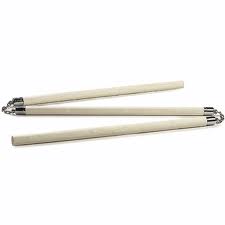
Sansetsukon - Japan / China - The 3 section staff is one of the hardest weapons to master due to the flexibility of the weapon. The advantage is it can be used in may different lengths and is very hard to defend against. It was a weapon that the Chinese used due to the difficulity in defending against.


Juijiebian / Surujin - Okinawa / China - The 9 section chain whip / Rope is a soft weapon. It was developed to be conceiled and can be used to keep an attacker at distance. The weapon can be used at full length or doubled over for a faster strike. Flags would be attached at the handle / weight end of the chinese version to help balance the weapon once spinning and weights on the Okinawan version.

Shuriken - Japan - Both hira and bo shuriken are used not just for throwing but for close quarter combat. Used mostly by the ninja to confuse and injure the samurai before killing. They would also be pushed into mud to injure once stood on or coated in feaces so to contaminate any wounds.